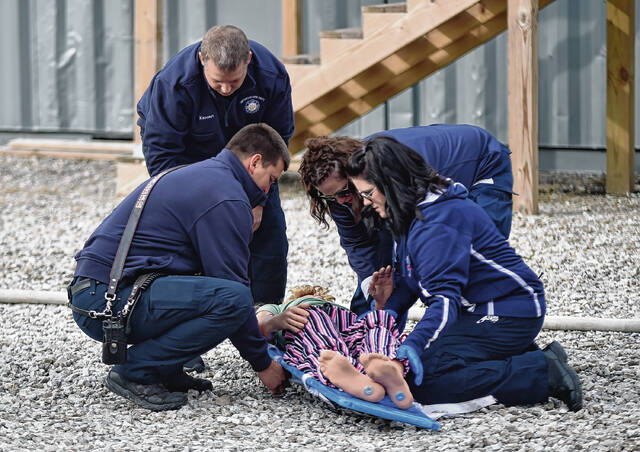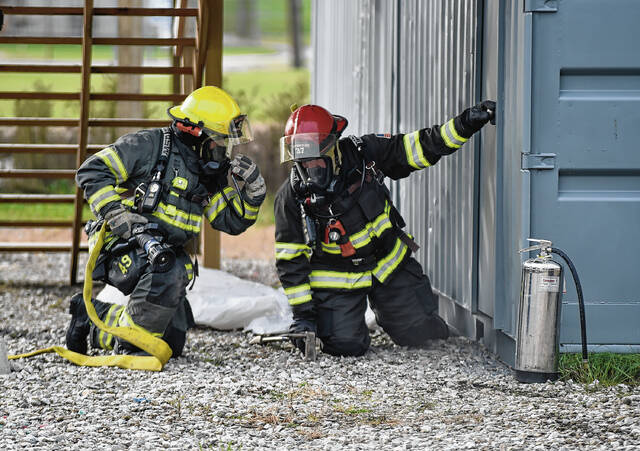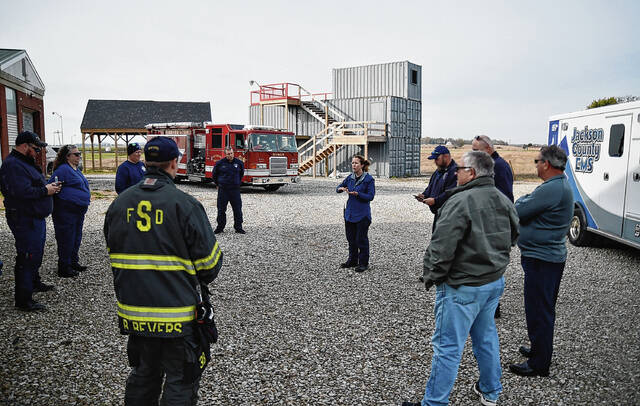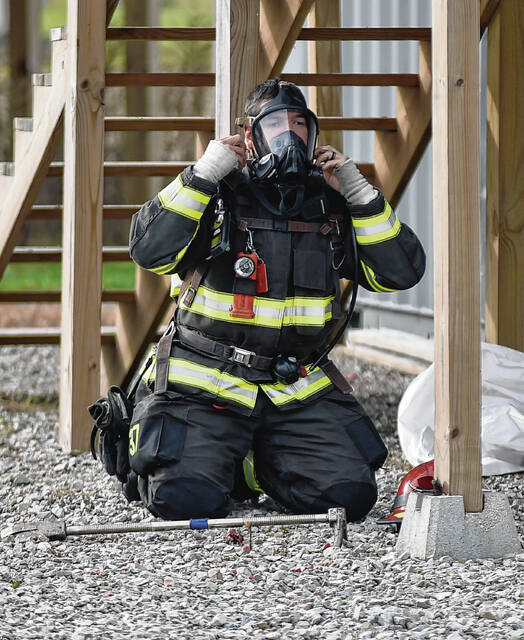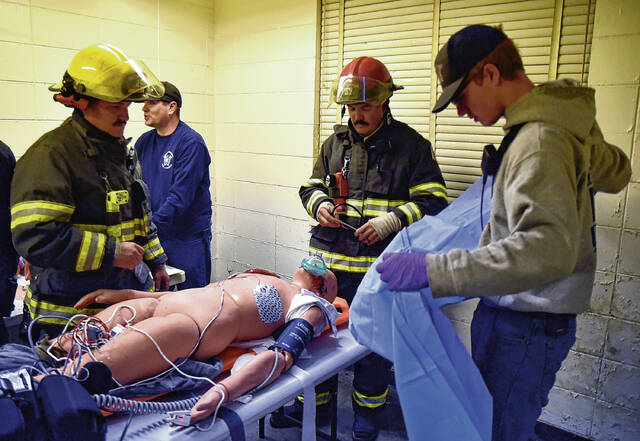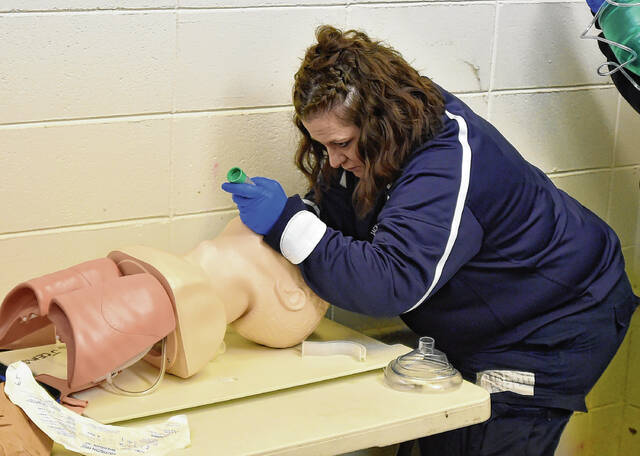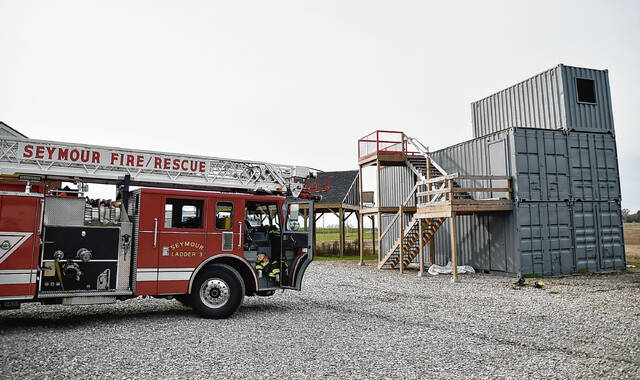As Seymour firefighters arrive on the scene, a woman approaches them saying three people are inside the burning structure.
The firemen immediately jump into action, grabbing tools and pulling out a fire hose before crawling into the smoke-filled building.
Shortly after, two of them carry an adult male from the building. By that time, Jackson County Emergency Medical Services personnel have arrived, and they place the man on a portable stretcher.
The firefighters go right back in and rescue an adult female and a baby, also placing the woman on a stretcher and carrying the baby straight to an ambulance.
Once in the ambulance, paramedics and emergency medical technicians work to save the three people’s lives.
While this wasn’t a real scenario, it provided valuable training for local first responders.
This was done over three days last week at the fire training facility on G Avenue West in Freeman Field in Seymour.
Being in operation for the past year, Seymour Fire Chief Brad Lucas said the facility has brought many benefits to his department.
Perhaps the biggest benefit?
“This type of scenario is about as ideal and realistic as you could get,” Lucas said of the recent search-and-rescue training.
Before the facility was available, he said firefighters would use a vacant home purchased by Schneck Medical Center to smoke up and do ladder training, but once it was torn down, they didn’t have that option. They also could smoke up the firehouse, but that’s not ideal, either.
Another option was for firefighters to travel to other cities that have fire training facilities, but Lucas said that meant taking a firetruck out of service and bringing in other firefighters to cover for them.
With Seymour having its own fire training facility, firefighters can do all of their training in a building that’s theirs and is available any time.
“The big benefit for us is we’ve hired so many guys the last two years and we get them out here and get them in some training right away,” Lucas said. “The very first thing you teach them is to get comfortable in their gear, get comfortable with SCBA (self-contained breathing apparatus), and their No. 1 job is fight a fire, bring out victims, things like that, and we can do that right here.”
Lucas said building a fire training facility was on his mind for several years, but the wheels didn’t go in motion until three years ago after an ISO audit. The Insurance Services Office creates ratings for fire departments and their surrounding communities to calculate how well-equipped departments are to put out fires in that community.
“One of the things that we knew we could do to improve our score was our training, and one of the things to do that is a training facility,” Lucas said.
Batallion Chief John Kirby said a certain percentage of firefighters’ training has to be at a fixed facility. Now that Seymour has its own, it will gain ISO points.
“Before, we just couldn’t get those points,” he said.
As Lucas started researching fire training facilities, he learned the Indiana Department of Homeland Security had secured 20-foot shipping containers from Naval Support Activity Crane, so he got five of them. Plus, he purchased two 40-foot containers.
Once gravel was put down in the parking lot and the containers were delivered, the interior of the ground-level containers was set up like a house, including holes cut to make doorways and furniture placed throughout.
That was functional at the end of the summer in 2020.
“We can make it realistic as a house and smoke it up and go through like you would in a house fire passing through doorways,” Lucas said.
Then the department received a grant from the Community Foundation of Jackson County so the containers could be painted and a railing could be added to reach the upper levels of the stacked containers.
The second story includes a maze known as a confidence course that can be smoked up or blacked out for training scenarios, and the third story has a window set up on the outside that can be used for ladder training.
“One of the (benefits) is being able to ladder a structure and not tear it up,” Kirby said. “Before, we would have to ladder the fire station or ladder a house, and that’s hard on gutters and things like that. You don’t do as much ladder training that way. Now, we can do as much ladder training as we want, we have the place to do it and we can ladder the building and not tear anything up.”
Kirby said since the facility is already set up, firefighters can go there in a moment’s notice and train.
“We’ve done that where we’ve just said, ‘Go out to the training grounds and ladder this building and do it,’ and we can do the training and be done with it and pack up and come back and we’ll do other stuff,” he said.
The grounds also include a roof prop with four pitches that was built this year.
“Right now, it’s not finished, but when it is, they can put a ladder up to it, put a ladder over the top and have a ladder on the roof and then use a chainsaw to cut a hole in it and we could replace that piece,” Lucas said. “That’s not fully functional yet. At some point, we hope to dig that out, put concrete underneath it, maybe put a storage room and a restroom in there.”
Lucas said the department saved a lot of money by having the firefighters do the work on the facility during their shift, rather than hiring a contractor.
Firefighters also can use the nearby brick building for training. During the recent search-and-rescue training sessions, rooms were set up like the back of ambulances to treat the patients.
Lucas said the building is owned by Freeman Municipal Airport, and part of it is still used by the Time Turners car club.
This year, he said firefighters are required to have 16 hours of training at the fire training facility.
The search-and-rescue training also gave Seymour firefighters a chance to earn emergency medical services hours, which are required to maintain certifications.
That served a dual purpose as Lucas wanted to set up interagency training after Neti Redelman was hired as the new education coordinator for Jackson County EMS. She led debriefings after each training session.
At the same time, the EMS personnel benefited from the training.
“Runs of this magnitude obviously don’t happen often, thankfully, but they do happen, so when they do, it’s good that we have this opportunity to be able to have gone through this training where we have multiple victims in a fire,” said Nate Bryant, executive director of Jackson County EMS.
“The fact that they are able to smoke up the building gives them their piece, and then this is how we work together every shift, so to be able to do it and train and then debrief and talk about it, it’s really vital,” he said.
Bryant said Redelman plans on doing quarterly trainings with volunteer fire departments, too. Hamilton Township Volunteer Fire Department had personnel involved in the recent training.
“When I became director, that was one of my goals is to increase that training, and Neti has done a fantastic job handling that,” Bryant said. “We’ve already had the crews saying how awesome this training was, so we’re hearing really good things about it.”
Lucas and Kirby both said another good thing about the training facility is there’s room to develop and expand. Containers could be added to train in different scenarios.
“What I like about the container concept is you just keep growing with it, you just keep adding onto it,” Lucas said. “It’s going to keep getting bigger.”




